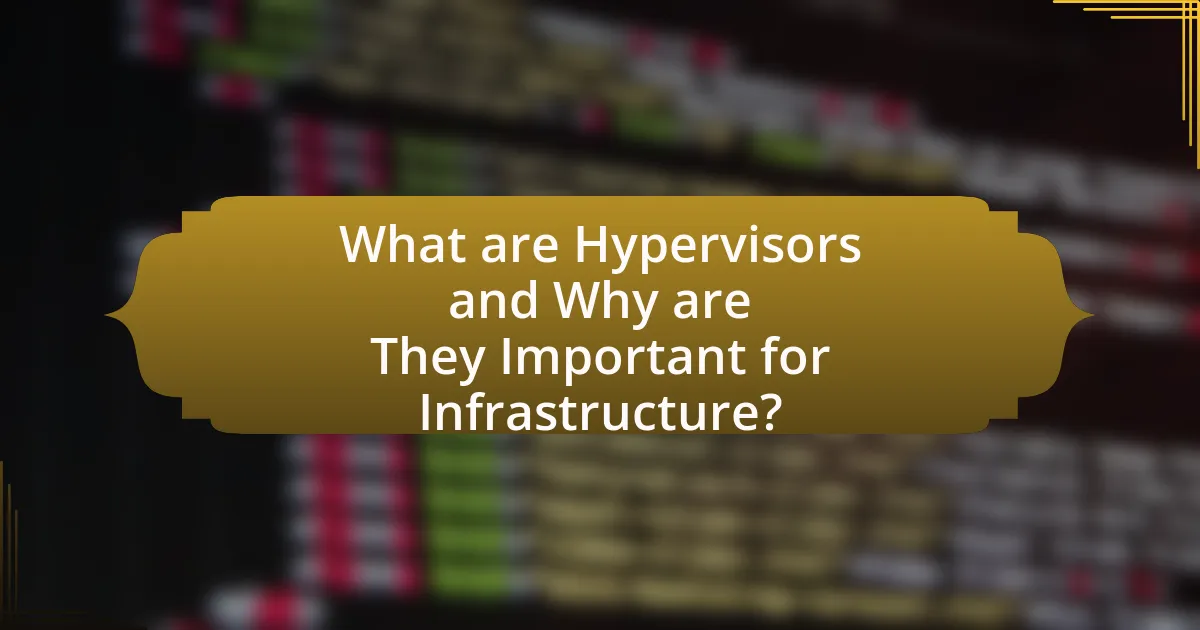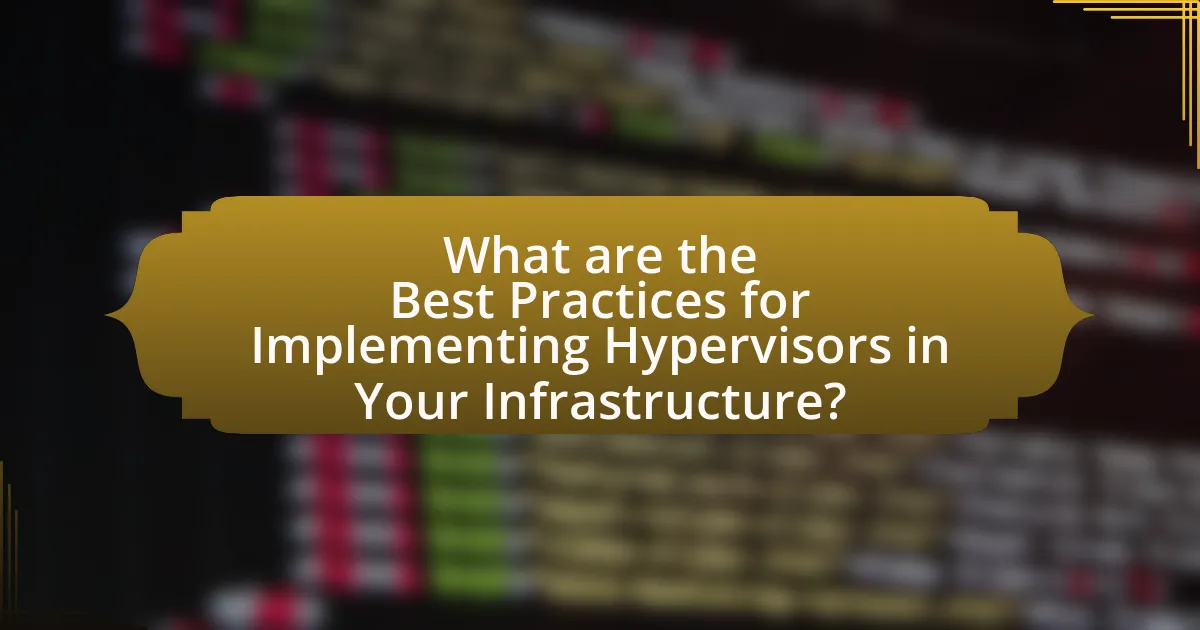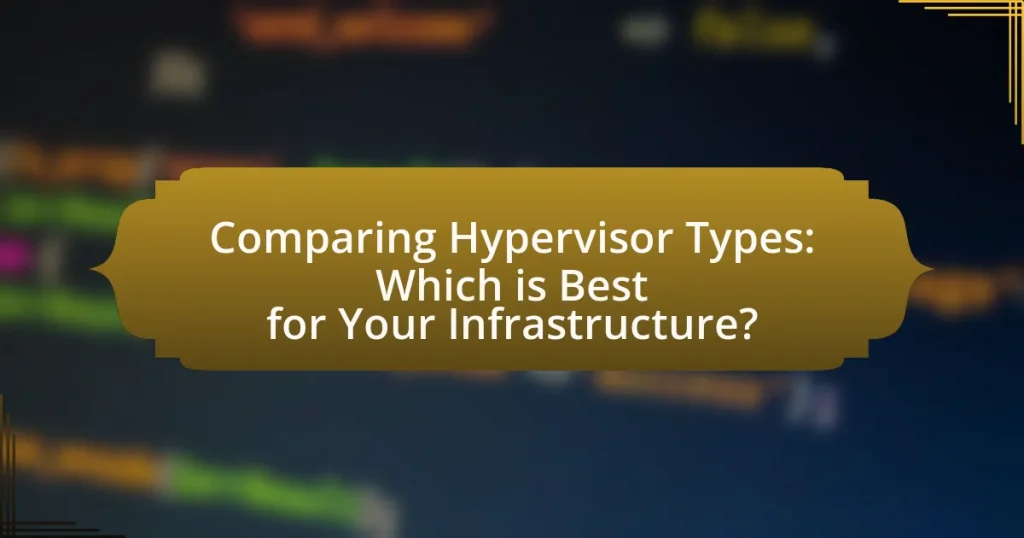Hypervisors are essential software or hardware platforms that create and manage virtual machines by abstracting physical hardware, enabling multiple operating systems to run concurrently on a single machine. This article compares the two main types of hypervisors—Type 1 (bare-metal) and Type 2 (hosted)—highlighting their differences in performance, scalability, and security implications. Key features, use cases, and factors influencing hypervisor selection are discussed, along with best practices for implementation and optimization in various infrastructure environments. The article aims to provide a comprehensive understanding of hypervisors to help organizations determine the most suitable option for their specific needs.
What are Hypervisors and Why are They Important for Infrastructure?

Hypervisors are software or hardware platforms that create and manage virtual machines by abstracting the underlying physical hardware. They are crucial for infrastructure as they enable multiple operating systems to run concurrently on a single physical machine, optimizing resource utilization and reducing costs. According to a report by Gartner, organizations that implement virtualization can achieve up to 70% better server utilization rates, demonstrating the efficiency and importance of hypervisors in modern IT environments.
What are the different types of hypervisors?
There are two main types of hypervisors: Type 1 (bare-metal) hypervisors and Type 2 (hosted) hypervisors. Type 1 hypervisors run directly on the hardware of the host machine, allowing for better performance and resource management, as seen in solutions like VMware ESXi and Microsoft Hyper-V. In contrast, Type 2 hypervisors operate on top of an existing operating system, which can lead to increased overhead and reduced performance, exemplified by software such as Oracle VirtualBox and VMware Workstation. This classification is widely recognized in virtualization technology, confirming the distinction between the two types based on their architecture and operational efficiency.
How do Type 1 hypervisors differ from Type 2 hypervisors?
Type 1 hypervisors run directly on the host’s hardware, while Type 2 hypervisors operate on top of a host operating system. This fundamental difference affects performance and resource management; Type 1 hypervisors typically offer better performance and efficiency because they have direct access to hardware resources, whereas Type 2 hypervisors may introduce additional overhead due to their reliance on the host OS. For instance, VMware ESXi is a Type 1 hypervisor that provides high performance for enterprise environments, while Oracle VirtualBox is a Type 2 hypervisor that is more suited for desktop virtualization.
What are the key features of each hypervisor type?
There are two main types of hypervisors: Type 1 (bare-metal) and Type 2 (hosted). Type 1 hypervisors run directly on the hardware, providing high performance and efficiency, as they do not require a host operating system. Examples include VMware ESXi and Microsoft Hyper-V. Type 2 hypervisors run on top of a host operating system, making them easier to set up and use, but they typically have lower performance due to the additional layer. Examples include Oracle VirtualBox and VMware Workstation. The key features of Type 1 hypervisors include direct hardware access, better scalability, and enhanced security, while Type 2 hypervisors offer user-friendliness, flexibility, and ease of installation.
What role do hypervisors play in virtualization?
Hypervisors are critical components in virtualization as they enable multiple virtual machines to run on a single physical host by abstracting the hardware resources. They manage the allocation of CPU, memory, and storage to each virtual machine, ensuring efficient resource utilization and isolation between different operating systems. For instance, Type 1 hypervisors, such as VMware ESXi and Microsoft Hyper-V, run directly on the hardware, providing better performance and scalability, while Type 2 hypervisors, like Oracle VirtualBox, operate on top of an existing operating system, offering flexibility for development and testing environments. This distinction highlights the hypervisor’s role in optimizing infrastructure by allowing organizations to consolidate workloads and improve operational efficiency.
How do hypervisors manage hardware resources?
Hypervisors manage hardware resources by abstracting and allocating physical resources such as CPU, memory, and storage to virtual machines. They achieve this through a process called virtualization, which allows multiple operating systems to run concurrently on a single physical machine. Hypervisors utilize a scheduling algorithm to distribute CPU time among virtual machines, ensuring efficient processing. Memory management techniques, such as ballooning and paging, optimize the allocation of RAM based on the needs of each virtual machine. Additionally, hypervisors can dynamically allocate storage resources, allowing for flexible scaling and efficient use of disk space. This resource management is crucial for maximizing hardware utilization and maintaining performance across virtual environments.
What impact do hypervisors have on system performance?
Hypervisors can significantly impact system performance by introducing overhead that affects resource allocation and processing efficiency. This overhead arises from the virtualization layer that hypervisors create, which can lead to increased latency and reduced throughput compared to running applications directly on physical hardware. For instance, Type 1 hypervisors, which run directly on the host machine’s hardware, typically offer better performance than Type 2 hypervisors, which operate on top of a host operating system. Studies have shown that Type 1 hypervisors can achieve near-native performance levels, while Type 2 hypervisors may incur up to 20% performance degradation due to additional processing requirements.
What factors should be considered when choosing a hypervisor?
When choosing a hypervisor, key factors include performance, scalability, compatibility, management features, security, and cost. Performance is critical as it affects the efficiency of virtual machines; for instance, Type 1 hypervisors typically offer better performance than Type 2 due to direct hardware access. Scalability is essential for accommodating future growth; a hypervisor should support a large number of virtual machines without degradation in performance. Compatibility with existing hardware and software environments ensures seamless integration and operation. Management features, such as ease of use and automation capabilities, can significantly impact operational efficiency. Security is paramount, as vulnerabilities in the hypervisor can expose all hosted virtual machines; thus, selecting a hypervisor with robust security measures is vital. Finally, cost considerations, including licensing fees and operational expenses, play a crucial role in the decision-making process.
How does scalability influence hypervisor selection?
Scalability significantly influences hypervisor selection by determining the hypervisor’s ability to efficiently manage increasing workloads and virtual machines. A hypervisor that supports horizontal scaling allows organizations to add more physical servers to accommodate growth, while vertical scaling enables the addition of resources to existing servers. For instance, VMware vSphere is known for its robust scalability features, supporting thousands of virtual machines on a single host and enabling seamless resource allocation as demand increases. This capability is crucial for businesses anticipating growth, as it ensures that the infrastructure can adapt without requiring a complete overhaul, thus optimizing both performance and cost-efficiency.
What are the security implications of different hypervisor types?
Different hypervisor types, namely Type 1 (bare-metal) and Type 2 (hosted), have distinct security implications. Type 1 hypervisors, which run directly on hardware, generally offer better security due to their reduced attack surface and isolation from the host operating system. This isolation minimizes the risk of vulnerabilities in the host OS affecting the virtual machines. In contrast, Type 2 hypervisors, which operate on top of a host OS, are more susceptible to security threats that target the host system, potentially compromising all virtual machines running on it.
For instance, a study by the National Institute of Standards and Technology (NIST) highlights that Type 1 hypervisors can provide stronger security controls and better performance, making them preferable for sensitive environments. Additionally, the lack of a host OS in Type 1 hypervisors reduces the number of potential vulnerabilities, as seen in the security architecture of VMware ESXi and Microsoft Hyper-V. Conversely, Type 2 hypervisors like Oracle VirtualBox and VMware Workstation are more vulnerable to malware and exploits targeting the host OS, which can lead to a cascading failure of security across all virtual machines.
How do hypervisors integrate with existing infrastructure?
Hypervisors integrate with existing infrastructure by abstracting hardware resources and enabling virtualization, which allows multiple operating systems to run concurrently on a single physical machine. This integration is achieved through the installation of the hypervisor on the host machine, which then manages the virtual machines (VMs) and allocates resources such as CPU, memory, and storage. For instance, Type 1 hypervisors, like VMware ESXi, run directly on the hardware, providing high performance and efficiency, while Type 2 hypervisors, such as Oracle VirtualBox, operate on top of an existing operating system, making them easier to deploy in environments where hardware resources are already in use. This flexibility allows organizations to optimize resource utilization, improve scalability, and enhance disaster recovery capabilities, thereby aligning with existing IT strategies and infrastructure.
What are the common use cases for each hypervisor type?
There are two main types of hypervisors: Type 1 (bare-metal) and Type 2 (hosted), each with distinct use cases. Type 1 hypervisors, such as VMware ESXi and Microsoft Hyper-V, are commonly used in enterprise environments for server virtualization, providing high performance and resource efficiency by running directly on hardware. They are ideal for data centers and cloud computing due to their ability to manage multiple virtual machines with minimal overhead.
Type 2 hypervisors, like Oracle VirtualBox and VMware Workstation, are typically used for desktop virtualization and development environments. They run on top of an operating system, making them suitable for individual users or small teams needing to run multiple operating systems on a single machine for testing or development purposes.
The distinction in use cases is supported by the architecture of each hypervisor type, where Type 1 offers better scalability and performance for large-scale deployments, while Type 2 provides flexibility and ease of use for personal or small-scale applications.
Which industries benefit most from Type 1 hypervisors?
The industries that benefit most from Type 1 hypervisors include data centers, cloud computing, telecommunications, and enterprise IT. These sectors leverage Type 1 hypervisors for their ability to provide high performance, security, and efficient resource management. For instance, data centers utilize Type 1 hypervisors to optimize server utilization and reduce hardware costs, while cloud computing providers rely on them to deliver scalable and reliable virtualized environments. Additionally, telecommunications companies benefit from the enhanced security features of Type 1 hypervisors, which are crucial for managing sensitive data and ensuring service continuity.
What scenarios favor the use of Type 2 hypervisors?
Type 2 hypervisors are favored in scenarios where ease of use and flexibility are paramount, particularly in desktop virtualization environments. These hypervisors run on top of a host operating system, allowing users to quickly set up and manage virtual machines without requiring dedicated hardware. This is particularly beneficial for developers and testers who need to run multiple operating systems on a single machine for application compatibility testing. Additionally, Type 2 hypervisors are ideal for personal use or small-scale deployments, where users may not have extensive IT infrastructure or resources. Their integration with existing operating systems simplifies the installation process and enhances user accessibility, making them suitable for educational purposes and casual virtualization tasks.
What are the Pros and Cons of Each Hypervisor Type?

There are two main types of hypervisors: Type 1 (bare-metal) and Type 2 (hosted), each with distinct pros and cons. Type 1 hypervisors, such as VMware ESXi and Microsoft Hyper-V, offer high performance and efficiency since they run directly on the hardware without a host operating system. This direct access to hardware allows for better resource management and scalability, making them ideal for enterprise environments. However, they require more complex setup and management, which can lead to higher operational costs.
Type 2 hypervisors, like Oracle VirtualBox and VMware Workstation, run on top of a host operating system, making them easier to install and use, particularly for development and testing environments. They provide flexibility and are suitable for desktop virtualization. However, their performance is generally lower than Type 1 hypervisors due to the additional overhead of the host OS, which can limit resource allocation and scalability.
In summary, Type 1 hypervisors excel in performance and scalability but come with complexity, while Type 2 hypervisors offer ease of use and flexibility at the cost of performance.
What advantages do Type 1 hypervisors offer?
Type 1 hypervisors offer superior performance and efficiency compared to Type 2 hypervisors because they run directly on the host’s hardware without an underlying operating system. This direct access to hardware resources allows for better resource allocation, reduced latency, and improved scalability. Additionally, Type 1 hypervisors provide enhanced security features, as they have a smaller attack surface due to the absence of a host OS, making them less vulnerable to malware and other security threats. These advantages make Type 1 hypervisors particularly suitable for enterprise environments where performance, security, and resource management are critical.
How do Type 1 hypervisors enhance performance and efficiency?
Type 1 hypervisors enhance performance and efficiency by running directly on the host hardware, which eliminates the overhead associated with a host operating system. This direct access to hardware resources allows for better resource allocation and management, resulting in improved performance for virtual machines. Additionally, Type 1 hypervisors can optimize CPU, memory, and I/O operations more effectively than Type 2 hypervisors, which rely on a host OS. Studies have shown that Type 1 hypervisors can achieve higher throughput and lower latency, making them suitable for enterprise environments where performance is critical.
What are the limitations of Type 1 hypervisors?
Type 1 hypervisors have several limitations, including hardware dependency, complexity in management, and limited compatibility with certain operating systems. These hypervisors run directly on the host’s hardware, which means they require specific hardware configurations and may not support all hardware components, leading to potential compatibility issues. Additionally, the management of Type 1 hypervisors can be complex, requiring specialized knowledge and skills to configure and maintain, which can increase operational overhead. Furthermore, some Type 1 hypervisors may not support all guest operating systems, restricting the flexibility of the virtualized environment.
What benefits do Type 2 hypervisors provide?
Type 2 hypervisors provide benefits such as ease of use, flexibility, and cost-effectiveness. These hypervisors run on top of an existing operating system, allowing users to quickly set up and manage virtual machines without needing dedicated hardware. This architecture simplifies the installation process and enables users to leverage their current system resources efficiently. Additionally, Type 2 hypervisors often come with user-friendly interfaces and tools that facilitate the management of virtual environments, making them accessible for less technical users. Their ability to run on various host operating systems further enhances their versatility, allowing for diverse deployment scenarios.
How do Type 2 hypervisors improve accessibility for users?
Type 2 hypervisors improve accessibility for users by allowing them to run multiple operating systems simultaneously on a single physical machine without requiring complex configurations. This user-friendly approach enables individuals to easily switch between different environments, such as Windows and Linux, enhancing productivity and flexibility. Additionally, Type 2 hypervisors often integrate seamlessly with host operating systems, providing a familiar interface that simplifies the virtualization process for users who may not have extensive technical expertise.
What challenges are associated with Type 2 hypervisors?
Type 2 hypervisors face several challenges, primarily related to performance and resource management. Unlike Type 1 hypervisors, which run directly on hardware, Type 2 hypervisors operate on top of a host operating system, leading to increased overhead and reduced efficiency. This architecture can result in slower virtual machine (VM) performance due to the additional layer of abstraction, which can hinder resource allocation and management. Furthermore, Type 2 hypervisors are more susceptible to security vulnerabilities, as they rely on the host OS for security measures, making them less robust in isolated environments. Additionally, compatibility issues may arise with certain applications or hardware, limiting the flexibility and scalability of virtualized environments.
How do the costs of different hypervisors compare?
The costs of different hypervisors vary significantly based on licensing models, features, and support options. For instance, VMware vSphere typically incurs higher licensing fees, often exceeding $1,000 per CPU, while open-source options like KVM and Xen can be utilized at no cost, although they may require additional expenses for support and management. Microsoft Hyper-V offers a more moderate pricing structure, often bundled with Windows Server licenses, making it cost-effective for organizations already using Microsoft products. Additionally, the total cost of ownership can be influenced by factors such as scalability, performance, and the specific needs of the infrastructure, which can lead to varying long-term costs across different hypervisors.
What are the licensing considerations for each hypervisor type?
The licensing considerations for hypervisor types vary significantly among the main categories: Type 1 (bare-metal) and Type 2 (hosted). Type 1 hypervisors, such as VMware vSphere and Microsoft Hyper-V, typically require a paid license based on the number of physical CPUs or cores, with additional costs for advanced features and support. For instance, VMware vSphere’s licensing is based on CPU sockets, while Microsoft Hyper-V is included with Windows Server licenses, which can also incur additional costs for client access licenses (CALs).
In contrast, Type 2 hypervisors, like Oracle VirtualBox and VMware Workstation, often have free versions available, but may also offer paid versions with enhanced features and support. For example, VMware Workstation Pro requires a one-time purchase for a license, while Oracle VirtualBox is open-source and free to use, although it may have limitations in enterprise environments.
These licensing models reflect the deployment scale and feature sets required by organizations, influencing the total cost of ownership and operational flexibility.
How do operational costs vary between Type 1 and Type 2 hypervisors?
Operational costs for Type 1 hypervisors are generally lower than those for Type 2 hypervisors. Type 1 hypervisors run directly on the hardware, which allows for better resource utilization and performance efficiency, leading to reduced operational expenses related to hardware and energy consumption. In contrast, Type 2 hypervisors operate on top of a host operating system, which incurs additional overhead costs due to the need for more resources and potentially lower performance, resulting in higher operational costs. This distinction is supported by studies indicating that Type 1 hypervisors can achieve up to 20% better performance efficiency compared to Type 2 hypervisors, thereby reducing overall operational costs.
What are the Best Practices for Implementing Hypervisors in Your Infrastructure?

The best practices for implementing hypervisors in your infrastructure include selecting the appropriate hypervisor type, ensuring hardware compatibility, optimizing resource allocation, and maintaining security protocols. Choosing between Type 1 (bare-metal) and Type 2 (hosted) hypervisors is crucial, as Type 1 hypervisors typically offer better performance and efficiency for enterprise environments. Ensuring that the underlying hardware supports virtualization technologies, such as Intel VT-x or AMD-V, is essential for optimal performance.
Resource allocation should be carefully managed to prevent over-provisioning, which can lead to performance degradation; utilizing tools for monitoring and adjusting resource distribution can enhance efficiency. Additionally, implementing robust security measures, including regular updates, patch management, and network segmentation, is vital to protect virtual machines from vulnerabilities. These practices are supported by industry standards and guidelines from organizations like the National Institute of Standards and Technology (NIST), which emphasize the importance of security and performance in virtualization environments.
How can you ensure optimal performance with your chosen hypervisor?
To ensure optimal performance with your chosen hypervisor, you should allocate sufficient resources, configure settings for workload optimization, and regularly monitor performance metrics. Allocating adequate CPU, memory, and storage resources prevents bottlenecks and allows the hypervisor to efficiently manage virtual machines. Configuring settings such as CPU pinning, memory ballooning, and storage I/O controls can enhance performance based on specific workload requirements. Regularly monitoring performance metrics, such as CPU usage, memory consumption, and disk I/O, enables timely adjustments and troubleshooting, ensuring that the hypervisor operates at peak efficiency.
What configuration settings are essential for performance tuning?
Essential configuration settings for performance tuning include CPU allocation, memory management, disk I/O optimization, and network settings. CPU allocation ensures that virtual machines receive adequate processing power, while memory management involves configuring memory limits and reservations to optimize resource usage. Disk I/O optimization can be achieved through settings like storage type selection and caching strategies, which enhance data access speeds. Network settings, including bandwidth allocation and latency adjustments, are crucial for maintaining efficient communication between virtual machines. These settings collectively contribute to improved performance in virtualized environments, as evidenced by studies showing that optimized configurations can lead to significant reductions in latency and increases in throughput.
How can resource allocation be optimized in a virtual environment?
Resource allocation in a virtual environment can be optimized by implementing dynamic resource management techniques, such as load balancing and resource pooling. These techniques allow for the efficient distribution of computing resources based on real-time demand, ensuring that virtual machines receive the necessary resources without over-provisioning. For instance, using hypervisors that support features like live migration enables the redistribution of workloads across physical servers, which can enhance performance and reduce resource contention. Additionally, monitoring tools can provide insights into resource usage patterns, allowing administrators to make informed decisions about scaling resources up or down as needed.
What security measures should be taken when using hypervisors?
To enhance security when using hypervisors, implement measures such as regular updates, strong access controls, and network segmentation. Regular updates ensure that vulnerabilities are patched promptly, reducing the risk of exploitation. Strong access controls limit who can manage the hypervisor, preventing unauthorized access that could lead to breaches. Network segmentation isolates virtual machines, minimizing the impact of potential attacks and containing threats within specific segments. These practices are essential for maintaining a secure hypervisor environment and protecting the underlying infrastructure from various security threats.
How can you protect against vulnerabilities in hypervisor technology?
To protect against vulnerabilities in hypervisor technology, implement regular updates and patches to the hypervisor software. Keeping the hypervisor up-to-date mitigates known vulnerabilities, as evidenced by the fact that many security breaches exploit outdated software. Additionally, employing strong access controls and monitoring can prevent unauthorized access, which is crucial since hypervisors manage multiple virtual machines. According to the National Institute of Standards and Technology (NIST), maintaining a robust security posture through continuous monitoring and incident response is essential for safeguarding virtualized environments.
What best practices should be followed for hypervisor patch management?
Best practices for hypervisor patch management include establishing a regular patching schedule, testing patches in a controlled environment before deployment, and maintaining an inventory of hypervisor versions and configurations. Regular patching schedules help ensure that vulnerabilities are addressed promptly, reducing the risk of exploitation. Testing patches allows organizations to identify potential issues that could disrupt operations, ensuring stability and compatibility. Keeping an inventory of hypervisor versions aids in tracking which systems require updates and helps in compliance with security policies. These practices are essential for maintaining the security and performance of virtualized environments.
What are the common troubleshooting steps for hypervisor issues?
Common troubleshooting steps for hypervisor issues include checking system logs, verifying network configurations, ensuring adequate resource allocation, and updating hypervisor software. System logs provide insights into errors or warnings that may indicate the root cause of the issue. Verifying network configurations ensures that virtual machines can communicate effectively. Adequate resource allocation is crucial, as insufficient CPU, memory, or storage can lead to performance degradation. Finally, keeping hypervisor software updated addresses known bugs and vulnerabilities, enhancing stability and performance.
How can you diagnose performance problems in a virtualized environment?
To diagnose performance problems in a virtualized environment, utilize monitoring tools to analyze resource utilization, such as CPU, memory, disk I/O, and network bandwidth. These tools, like VMware vRealize Operations or Microsoft System Center, provide insights into the performance metrics of both the hypervisor and the virtual machines. By identifying bottlenecks in resource allocation, administrators can pinpoint whether the issue lies within the hypervisor configuration, the virtual machine settings, or the underlying hardware. For instance, a study by VMware found that improper resource allocation can lead to a 30% decrease in application performance, highlighting the importance of accurate monitoring and adjustment.
What tools are available for monitoring hypervisor health?
Tools available for monitoring hypervisor health include VMware vRealize Operations, Microsoft System Center Virtual Machine Manager, and Citrix Hypervisor Management Console. VMware vRealize Operations provides comprehensive monitoring and analytics for virtual environments, enabling administrators to assess performance and capacity. Microsoft System Center Virtual Machine Manager offers centralized management and monitoring capabilities for Hyper-V environments, allowing for real-time health checks. Citrix Hypervisor Management Console facilitates monitoring of Citrix hypervisors, providing insights into resource utilization and performance metrics. These tools are widely recognized for their effectiveness in maintaining hypervisor health and ensuring optimal performance in virtualized infrastructures.




